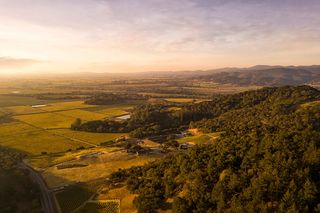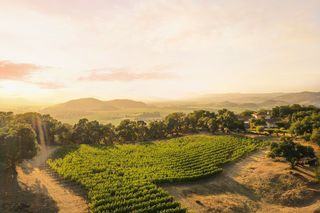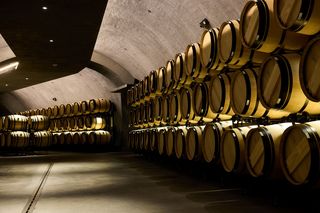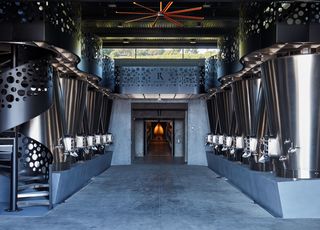We’ve always said that in winegrowing, Mother Nature has the final say. When we wrote the first draft of this story a couple months ago, we were in the midst of a multi-year drought that seemed to have no end in sight. Then October 24 came along, bringing an extreme rain event – what meteorologists call an “atmospheric river” – that dumped as much as 14 inches of water on Napa Valley in a 24-hour period. In the Stags Leap District, we got 8.5 inches, enough to nearly fill our reservoir, which had been completely dry through the 2021 growing season. Talk about a change in fortune.
Still, the rain wasn’t enough to completely head off the drought we’re experiencing, and while we’re in good shape for the coming growing season, we know there will be more drought years in the future. That prospect, combined with the heat spikes that have become more prevalent here, are tests of our long-term resilience and ability to work with forces out of our control. And yet, as farmers we find reasons to remain optimistic.
Partly this stems from significant advances in water conservation over the last 20 years. As an industry we’ve learned so much about how to design vineyards to optimize water use, everything from planting drought-resistant rootstocks and clones to proper vine row orientation for sun exposure to how we design and manage trellises and vine canopies through the growing season. New technology we couldn’t even imagine two decades ago, instruments in the vineyard such as sap flow sensors and pressure bombs, give us precise information about the vines’ use of and need for water. These sensors allow us to irrigate much more judiciously, only when the plants need it, not only saving water but increasing fruit quality as well.
Benoit:“Before this technology farmers would irrigate by the calendar or by gut instinct, watering just to keep the plants green. Today we use around 65% less water per acre simply by utilizing these tools and optimizing water use.”
These advances give us confidence we’re moving in the right direction, though in a drought year like 2021 our wells and reservoir just couldn’t provide the amount of water we needed. We completely rebuilt our reservoir in 2020, which meant we started 2021 with an empty pond. Because it rained so little early in the year, we made the difficult decision to truck in recycled water from the local sanitation district for irrigation. We understand this isn’t a sustainable solution, but it gave us enough water to get through the growing season, and our 2021 crop was healthy. Long term, our intent is to have a self-sustaining pond with runoff from the surrounding hillsides, but of course that depends on healthy rainfall.
At Farella we are working on a much more viable long-term plan, which includes hooking up to the county’s underground pipe that circulates recycled water throughout the Coombsville district. We know there is much more innovation and work to do on water sources for all vineyards and wineries in Napa Valley.
We’re also learning how to work around heat spikes, which can have a profound effect on fruit viability and quality.
Benoit:“Grapevines are actually pretty resilient when it comes to heat, Cabernet Sauvignon more so than Merlot. But it’s the extreme heat spikes, when temperatures rise to 100°F or more and stay there for several hours or even days, that can change the physiology of the grapes. So we’re very attuned to how many heat events like these we have, and particularly how many we experience late in the season, as we get closer to harvest.”
Shade cloths in the vineyard, which have a porosity of @40%, help us protect the fruit. And the misting systems we’ve installed in our Stags Leap Estate Vineyard and Upper Range look to be a game changer. When a heat spike occurs, we can turn on the misters and lower the temperature around the vines enough to where they can withstand the event. We can actually control the microclimate right around the fruit.
Benoit:“We have so many tools at our disposal, we just have to be smart about how we use them. And we need to think big, bigger than we have as an industry in the past. We need to embrace science and technology and be willing to invest in our future.”
Benoit points to some of the technologies we’ve borrowed from other industries, such as optical sorters. Coffee producers in Hawaii have used them for decades to sort coffee beans, but they’ve only become commonplace in the wine industry in the last several years. Likewise, automatic bin washers that can sanitize bins in seconds using less water were customary in the Central Valley with crops like apples and apricots well before they were used for wine grapes.
Benoit:“We have such a high value crop, we should be leading, not following, with technologies like these. I get frustrated when I see some growers unwilling to invest in science and technology. There can be a disconnect between what growers and wineries charge vs. what they invest in their vineyards. I think that has to change.”
Benoit has no shortage of ideas when it comes to the future of winegrowing in Napa Valley. With climate change and the specter of more extreme weather on the horizon, not to mention the fires we’ve been through in 2017 and 2020, thinking of ways to protect our vineyards is often on his mind.
Benoit:“Think about those retractable pool covers you see. Why not create something like that with a shade cloth that you can roll out over the vines quickly when a heat event is coming, and roll back again when it’s over? Or how about creating some kind of box around the vineyard, where you’d have filtered light coming in and control the temperature by misting? If there was a fire, I could enclose my vineyards, filter the air and keep out the smoke. The grapes wouldn’t even know there was a fire! That would be my dream. I see other agricultural crops enclosed by large tents, why not grapevines? It’s going to come down to economics. None of this would be inexpensive. But if you’re investing a few million dollars to protect your vineyards for the next 30 or 40 years? The return is going to be there.”
There’s no doubt that climate change will inform our thinking about winegrowing for the foreseeable future. But as farmers we are getting accustomed to dealing with different growing seasons, and the changes and challenges each one brings. Drought will continue to be an issue, and having access to the water we need will take long term planning and a fair amount of infrastructure. We’re working on it.
Scott:“It goes back to stewardship and resilience, both at the core of Realm Cellars. With viticulture, when I think about how far the industry has come, and how far we’ve come at Realm, I can’t help but be hopeful. Like Benoit says, we already have so many tools at our disposal. And I’m confident there will be game-changing technologies we can’t even imagine now. Maybe even some we invent ourselves.”




